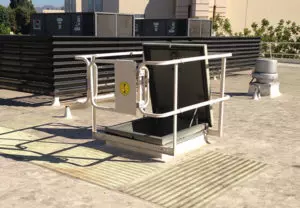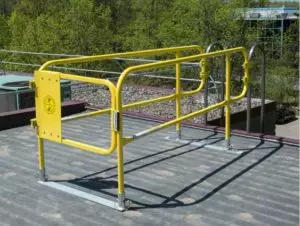As a safety manager or CEO, you likely focus the majority of your roof fall protection efforts on reducing fall risks around the edges of a roof. However, there are other rooftop fall risks that warrant attention. Failure to devote attention to these risks can leave employees and visitors at heightened risk for injury. Below is a glimpse of some commonly overlooked rooftop fall hazards and how guardrails can help you keep employees safe and avoid costly OSHA fines.
The most effective approach to rooftop safety is a comprehensive strategy that addresses all fall hazards - not just roof-edge fall hazards. Some commonly overlooked rooftop fall hazards that should be addressed include the following:
 1) Hatchways and Skylights
1) Hatchways and Skylights"OSHA concludes that a skylight should be regarded as a hatchway, i.e., an opening in the roof of a building through which persons may fall. 29 CFR 1910.28(b)(3)(i) therefore, requires that skylights in the roof of buildings through which persons may fall while walking or working shall be guarded by a standard skylight screen or a fixed standard railing on all exposed sides." - John B. Miles, Jr., Director, Field Operations, OSHA
OSHA categorizes skylights and hatchways as openings in buildings through which people can fall. Because some skylights and hatchways are nearly flush with the roof's surface and are incapable of supporting heavy weights, employees can sustain a fall with just one misstep.
Rooftop construction often requires workers to navigate up and around piping, ductwork, cables and other building materials. Construction also may also involve exposure to roof holes that are created while installing skylights or vents. Workers who fail to see exposed pipes, vents, or cables while working on a roof are at increased risk of trips and falls.

Another overlooked rooftop fall risk is exposure to rooftops that have varying levels. Failure to notice drop-offs from one rooftop level to the next can result in accidents and injury. In particular, OSHA notes that "each employee on a walking/working surface 6 feet (1.8 m) or above a lower level where leading edges are under construction, but who is not engaged in the leading edge work, shall be protected from falling by a guardrail system." Whether work is occurring on these levels or not, employees should be properly protected from fall risks at all times.
 4) Ladders and access points
4) Ladders and access points"Many rooftop fall accidents and injuries occur not on the roof itself, but when accessing it. Employees must be taught proper ladder and climbing safety when accessing roofs from below, and all equipment used to access a roof must be properly stabilized. Points of failure can occur around even stabilized equipment, so the roof itself must be inspected and safe before attempting to reach it." - OHS Canada
Ladders, hatchways and other roof access points are areas of increased risk for falls on any industrial rooftop. Due to their exposure to the elements, and requirement of employee coordination when in use, these rooftop areas have all the more need for proper fall protection equipment and employee safety training.
"Each employee in a hoist area shall be protected from falling 4 feet or more by guardrail systems or personal fall arrest systems. If guardrail systems (or chain gate or guardrail) or portions thereof must be removed to facilitate hoisting operations...that employee must be protected by a personal fall arrest system." - OSHA
Hoisting areas should be well-protected by an effective roof fall protection system. This system is typically a guardrail system that consists of a removable guardrail section that features middle and top rails.
Guardrails play a critical role in rooftop fall prevention. By positioning guardrails around skylights, access points, and machinery, you can help reduce the number of rooftop falls. Notably, studies undertaken to assess the effectiveness of safety railing systems support their use as a means of perimeter guarding and preventing workers from falling through skylights and hatchways. Here are a few of the benefits that safety railings can offer as a means of protecting employees from the five hazards outlined above:
Experts in the roof fall protection industry recognize that one size does not fit all needs when guardrails are being considered. Top guardrail manufacturers offer a host of different models to protect against the different types of rooftop hazards. Some of the most useful types of rooftop guardrails include the following:
Regulatory compliance is a top priority for safety-minded facility managers. Fortunately, the nation's most accomplished guardrail providers recognize the need for equipment compliance and construct guardrails that meet or exceed OSHA standards.
Gone are the days when nearly all safety railing systems were built with the same materials. Today's top safety railing systems are constructed of fiberglass and other materials. They are available in a variety of color choices and connector options to meet your needs. Some guardrails even feature solar-powered lighting to help prevent falls after dark.
While safety managers generally do an effective job of providing fall protection around the edges of a roof, they sometimes overlook other rooftop fall hazards such as skylights, machinery, and uneven roof levels. Fortunately, safety railing systems offer a convenient, cost-effective means of protecting workers and visitors from these hazards.